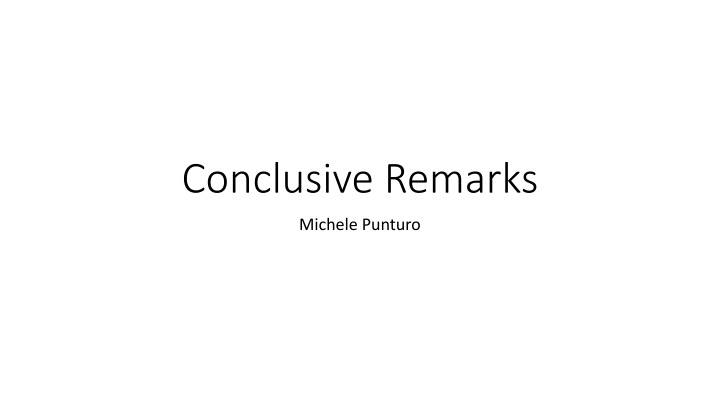
Michele Punturo Conclusive Remarks and CoBA Science Document Insights
"Explore the engaging discussion and outcomes from Michele Punturo's conclusive remarks, CoBA science document detailing ET observatory options, and next steps in analyzing risks and costs. Dive into the latest developments shaping the future of the Einstein Telescope project." (Approximately 315 characters)
Uploaded on | 3 Views
Download Presentation

Please find below an Image/Link to download the presentation.
The content on the website is provided AS IS for your information and personal use only. It may not be sold, licensed, or shared on other websites without obtaining consent from the author. If you encounter any issues during the download, it is possible that the publisher has removed the file from their server.
You are allowed to download the files provided on this website for personal or commercial use, subject to the condition that they are used lawfully. All files are the property of their respective owners.
The content on the website is provided AS IS for your information and personal use only. It may not be sold, licensed, or shared on other websites without obtaining consent from the author.
E N D
Presentation Transcript
Conclusive Remarks Michele Punturo
Comments Very high participation both in person and remotely Totale 90 80 70 60 50 40 Totale 30 20 10 0 Belgium China France Germany Ghana Hungary Italy Japan Netherlands Poland South Korea Spain Switzerland Taiwan United Kingdom (vuoto)
Comments Very high participation both in person and remotely We discussed crucial items for the future of Einstein Telescope CoBA science document Vacuum system requirements Recycling Cavity Design Thermal load and heat extraction from ET-LF payload
CoBA Science document An important deliverable has been produced by the collaboration A 140 pages document describing different options for the ET observatory realization with a scientific metric to compare it It will be circulated in the full collaboration in the next weeks This work has a double origin: The need to optimize the science return of ET (mainly our business) The need to match the ET cost structure with the possible funding architecture (mainly agency business) The effective kick-off of this process has been the Cost-Benefit Analysis (CoBA) full immersion workshop, Cortona 24-26 November https://indico.ego-gw.it/event/305/ One year after we achieved the first crucial milestone, but it is not the end of the path
CoBA next steps The CoBA configurations need to be analysed from the point of view of risks and costs. Which configurations? We are in 2022, we aren t doing an academic exercise after the delivering of CDR (2011). We have to compare realistic scenarios compatible with the existing or highly probable funding sources Already in the ESFRI proposal we stated that beside the triangular reference solution we will investigate alternative geometries Considering the outcomes of the CoBA science document and the potential funding sources appeared in the last months it seems to be natural to restrict the next steps of our evaluation to the Triangle-10km-HFLF and the 2L-15km-HFLF-45 The natural localizations for the 2L is one in North Europe (EMR) and one in South Europe (Sardinia)
Risk Table evaluation We need to define: The risk categories Performance, Time, Cost, Complexity, Novelty, The risk metric: Evaluation of the probability of a risk and of its impact A team of ET members that will intensively work on this item on the next few months delivering, for the next ET symposium, a detailed Risk Table ISB and SPB people having a large experience on the current GW detectors To be discussed and defined in one of the next EB meetings
Parametric Cost study (CoBA) To complete the CoBA process, we need a cost comparison between the two configurations It needs to be parametric because we aren t ready to freeze now many of the parameters of the design This should be realized by the Civil Infrastructure division, now passed under the Project hat For this reason the EB has to wrap up the CoBA Science document in an envelope , summarizing its summary, endorsing the results and presenting it to the Project Directorate (PD) and to the BSR. The EB will ask to the PD to steer the study in parallel to the risk analysis in order to converge for the next ET symposium
The next ET symposium (and Annual meeting) The Next ET symposium should be in spring 2023, possibly in April The EB will interact with the CB in th enext weeks in order to define as soon as possible the exact date and the location Consequently the next Annual meeting will be in fall 2023, in October-November. Again, it will be optimal to decide as soon as possible when and where. We have also the monthly meetings (in remote connection). The next one will be in January, the date to be defined, because of some conflict in the scheduled day.
Thanks Thanks to EGO for the support: IT department for the multi-conference room support Administration & finance for financial support through the aHEAD2020 EU initiative Services (Coffee break, Lunches) Thanks to INFN Perugia for financial support (through aHEAD2020) on the tent structure (we haven t used so much)
